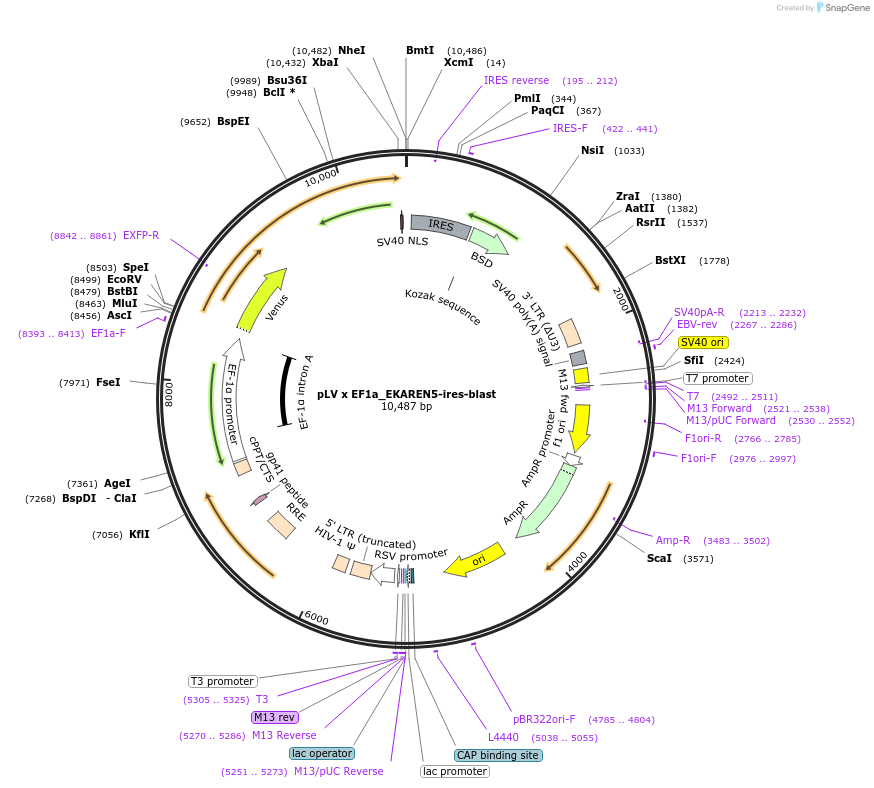pLV x EF1a_EKAREN5-ires-blast
(Plasmid
#167822)
-
PurposeOptimized EKAREV FRET biosensor sensor for ERK
-
Depositing Lab
-
Sequence Information
Ordering
| Item | Catalog # | Description | Quantity | Price (USD) | |
|---|---|---|---|---|---|
| Plasmid | 167822 | Standard format: Plasmid sent in bacteria as agar stab | 1 | $89 | |
Backbone
-
Vector backbonepLV lentiviral vector
-
Vector typeMammalian Expression, Lentiviral
-
Selectable markersBlasticidin
Growth in Bacteria
-
Bacterial Resistance(s)Ampicillin, 100 μg/mL
-
Growth Temperature37°C
-
Growth Strain(s)NEB Stable
-
Copy numberHigh Copy
Gene/Insert
-
Gene/Insert nameEKAREN5
-
SpeciesSynthetic
-
Insert Size (bp)1950
-
MutationK424P, K426W
- Promoter EF1a
-
Tag
/ Fusion Protein
- nls localization motif (C terminal on insert)
Cloning Information
- Cloning method Ligation Independent Cloning
- 5′ sequencing primer TGGAATTTGCCCTTTTTGAG
- 3′ sequencing primer AATGTTAACGACCGGt
- (Common Sequencing Primers)
Resource Information
-
Supplemental Documents
-
A portion of this plasmid was derived from a plasmid made byEKAREV (Komatsu et al.)
Terms and Licenses
-
Academic/Nonprofit Terms
-
Industry Terms
- Not Available to Industry
Trademarks:
- Zeocin® is an InvivoGen trademark.
Depositor Comments
We received EKAREV FRET biosensor from Matsuda-lab (Japan). We subsequently improved by insertion of a Turquoise2 synthetic DNA, including 169 silent mutations (reducing recombination) and adapted the sensor domain by point mutagenesis.
These plasmids were created by your colleagues. Please acknowledge the Principal Investigator, cite the article in which the plasmids were described, and include Addgene in the Materials and Methods of your future publications.
-
For your Materials & Methods section:
pLV x EF1a_EKAREN5-ires-blast was a gift from Hugo Snippert (Addgene plasmid # 167822 ; http://n2t.net/addgene:167822 ; RRID:Addgene_167822) -
For your References section:
Quantifying single-cell ERK dynamics in colorectal cancer organoids reveals EGFR as an amplifier of oncogenic MAPK pathway signalling. Ponsioen B, Post JB, Buissant des Amorie JR, Laskaris D, van Ineveld RL, Kersten S, Bertotti A, Sassi F, Sipieter F, Cappe B, Mertens S, Verlaan-Klink I, Boj SF, Vries RGJ, Rehmann H, Vandenabeele P, Riquet FB, Trusolino L, Bos JL, Snippert HJG. Nat Cell Biol. 2021 Apr;23(4):377-390. doi: 10.1038/s41556-021-00654-5. Epub 2021 Apr 1. 10.1038/s41556-021-00654-5 PubMed 33795873



